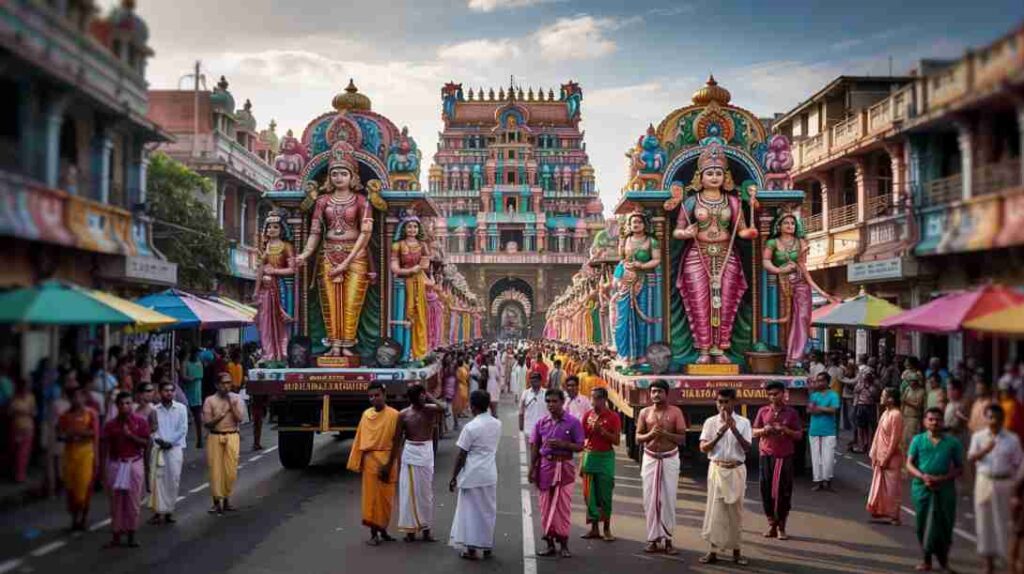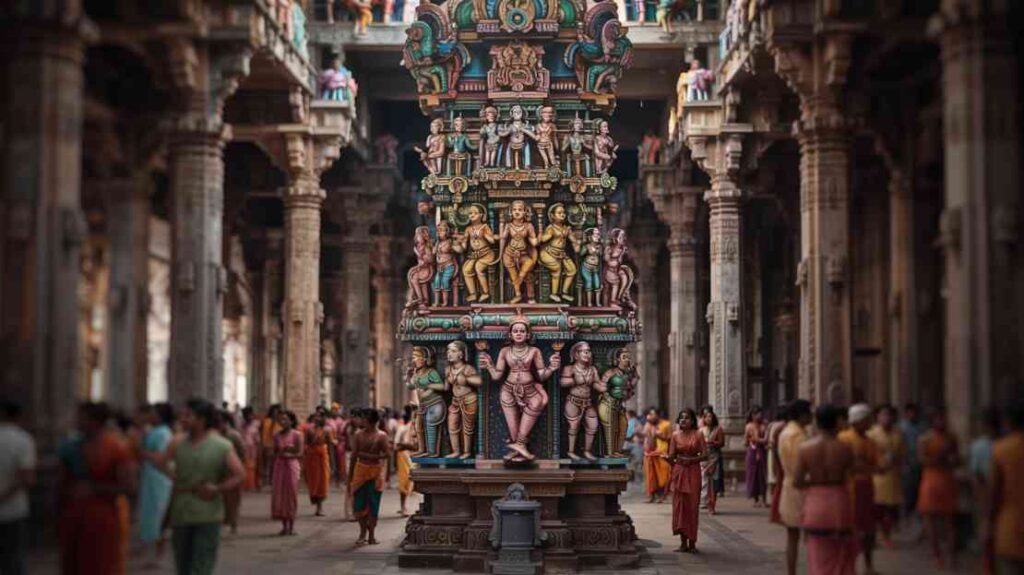The Meenakshi Temple History is a captivating saga of divine legends, architectural grandeur, and cultural resilience that has unfolded over more than two millennia in the heart of Madurai, Tamil Nadu. Nestled on the southern banks of the Vaigai River, the Meenakshi Temple, also known as Meenakshi Amman Temple or Meenakshi-Sundareswarar Temple, stands as a monumental testament to South India’s spiritual and artistic heritage. Dedicated to Goddess Meenakshi, an incarnation of Parvati, and Lord Sundareswarar, a form of Shiva, this iconic Dravidian masterpiece has been a beacon of devotion and a cultural cornerstone since antiquity. The Meenakshi Temple History encompasses its mythical origins tied to divine unions, its evolution through the patronage of Pandya, Vijayanagara, and Nayak dynasties, and its survival through invasions and colonial neglect. From towering gopurams adorned with vibrant sculptures to vibrant festivals like the Meenakshi Thirukalyanam, the temple’s legacy reflects Tamil Nadu’s enduring spirit. This article delves into the rich tapestry of Meenakshi Temple History, exploring its ancient roots, architectural marvels, and continued relevance as a global cultural landmark.
Origins and Mythological Foundations

Divine Legends
The Meenakshi Temple is steeped in rich mythology that underscores its spiritual significance. According to legend, King Malayadwaja Pandyan and Queen Kanchanamalai, childless after years of longing, performed a Putra Kameshti Yagam, a sacrificial ritual to beseech divine offspring. From the sacred fire emerged Goddess Parvati as Meenakshi, born with three breasts—a divine mark that would vanish upon meeting her destined consort. Named Tadaatagai, she grew into a fierce warrior-queen, succeeding her father as Madurai’s ruler. Her conquests led her to Mount Kailash, where she encountered Lord Shiva. Instantly enamored, her third breast disappeared as prophesied, and Shiva, as Sundareswarar, married her in a grand ceremony in Madurai, attended by Lord Vishnu, her divine brother. This divine wedding, reenacted annually, remains central to the temple’s identity.
Early Historical Evidence
While legends suggest origins dating back over 2,500 years, possibly linked to the mythical Kumari Kandam, historical records provide concrete evidence from the 6th century CE. Tamil Sangam literature references Madurai as a spiritual hub, with the temple at its core. The 7th-century saint Thirugnanasambandar praised the temple in his hymns, calling the deity “Alavai Iraivan.” Inscriptions from a recent study, documenting 410 engravings, reveal the deity’s early name as “Thirukkamakkottam Udaiya Aludaiya Nacchiyar” in 13th-century Pandya records, with “Meenakshi” appearing later in 1752 CE lamp engravings. These findings confirm the temple’s antiquity and its evolving nomenclature, reflecting shifting devotional practices.
Archaeological Insights
Archaeological evidence points to a structured temple by the 7th century CE, built under Pandya patronage. The temple’s early form likely featured simple sanctums aligned with Vastu Shastra principles, a hallmark of early Dravidian architecture. Inscriptions, primarily in Tamil with one in Sanskrit using Grantha script, highlight multicultural influences, underscoring Madurai’s role as a cosmopolitan center of trade and religion.
Architectural Evolution Through Dynasties

Pandya Foundations (6th–13th Century CE)
The Pandya dynasty laid the groundwork for the Meenakshi Temple’s architectural legacy. King Kulasekara Pandya is credited with establishing the twin shrines for Meenakshi and Sundareswarar in the 6th century CE, though these were modest compared to later expansions. By the 12th–13th centuries, Emperor Sadayavarman Kulasekaran I constructed the three-storied gopuram at the Sundareswarar shrine and parts of the Meenakshi shrine, introducing early Dravidian elements like symmetrical layouts and sculpted pillars depicting the divine marriage. These structures formed the temple’s core, setting a precedent for future grandeur.
Destruction and Vijayanagara Revival (14th–15th Century CE)
The temple faced a catastrophic setback in 1310–1311 CE when Malik Kafur, a commander under the Delhi Sultanate, invaded Madurai. His forces looted the temple’s treasures, desecrated its sanctums, and left the structure in ruins. Pandya king Vira Pandyan IV mounted a valiant defense, using the gopurams as archer posts and employing guerrilla tactics, but the city fell, and the temple languished under Muslim rule for nearly five decades. The Vijayanagara Empire’s conquest of Madurai in the late 14th century marked a turning point. The Vijayanagara rulers restored the sanctums, rebuilt damaged sections, and expanded courtyards, laying the foundation for the temple’s resurgence as a major pilgrimage site.
Nayak Dynasty’s Renaissance (16th–18th Century CE)
The Nayak dynasty, ruling Madurai from 1529 to 1736 CE, transformed the temple into a Dravidian masterpiece. Vishwanatha Nayak, the dynasty’s founder, fortified the complex with high walls and redesigned Madurai’s streets to radiate from the temple, aligning with Shilpa Shastra principles. However, it was Thirumalai Nayak (1623–1659 CE) who spearheaded the most ambitious expansions:
- Gopurams: He commissioned 14 towering gopurams, including the 170.6-ft southern tower, adorned with over 33,000 stucco sculptures depicting Hindu epics, celestial beings, and local legends.
- Mandapams: The Ayiramkaal Mandapam, with 985 intricately carved pillars, showcases deities, yali, and musicians, creating optical illusions of alignment. The Ashta Shakti Mandapam, with its hemispherical ceiling, and the 124-pillared Pudumandapam blend sacred and secular narratives.
- Musical Pillars: Granite columns in outer corridors produce distinct musical notes, demonstrating acoustic ingenuity.
- Golden Lotus Tank: Expanded with frescoed colonnades, it became a ritual centerpiece, linked to legends of Lord Indra’s divine encounter.
- Frescoes and Statues: Vibrant murals of Shiva’s miracles and statues of Nayak rulers enriched the temple’s artistic tapestry.
Thirumalai Nayak also unified the Saivaite Meenakshi Thirukalyanam with the Vaishnavite Alagar Festival, creating the Chithirai Thiruvizha, a cultural milestone that strengthened Madurai’s spiritual identity.
Architectural Splendor

Gopurams and Narrative Sculptures
The temple’s 14 gopurams are its most iconic feature, serving as both gateways and storytelling canvases. The southern gopuram, with 1,511 figures, and the eastern gopuram, with 1,011, depict scenes from the Ramayana, Mahabharata, and Meenakshi’s divine marriage. Nearly 4,000 mythological stories adorn the outer towers, painted in vivid colors that bring Hindu epics and Tamil legends to life. The southern gopuram’s design inspired the Tamil Nadu state emblem, underscoring its cultural significance.
Mandapams and Sacred Spaces
The Ayiramkaal Mandapam’s 985 pillars, each a sculptural masterpiece, create a mesmerizing visual and geometric effect. The Golden Lotus Tank, surrounded by murals of Shiva’s miracles, serves as a ritual bathing site. Musical pillars in outer corridors produce distinct notes when struck, reflecting advanced acoustic engineering. The twin sanctums, capped with gold-gilded vimanas, symbolize divine sanctity, accessible only to priests and visible from elevated vantage points.
Urban Integration
Madurai’s city layout, designed as concentric lotus petals radiating from the temple, adheres to Shilpa Shastra principles. Wide streets accommodate grand festival processions, with vehicles growing larger as they move outward, ensuring the temple remains the city’s spiritual and cultural heart.
Cultural and Religious Significance

A Living Temple
Unlike many ancient monuments, the Meenakshi Temple thrives as a vibrant center of worship. Daily rituals, conducted between 5:00 AM and 9:30 PM, include offerings, chants, and processions. Weekly ceremonies, such as seating golden figures of Meenakshi and Sundareswarar on a swing, symbolize their divine bond, accompanied by devotional hymns.
Festivals and Celebrations
The temple hosts numerous festivals, with the Meenakshi Thirukalyanam, a 12-day celebration in April–May, being the most prominent. Reenacting the divine wedding, it features grand processions, music, and floats across the Golden Lotus Tank, drawing millions of devotees. Other festivals include Navaratri, the Teppa festival, Aavanimoolam, and Alagar’s river plunge, each reinforcing the temple’s role as a cultural nexus.
Modern Restoration and Global Recognition
Colonial neglect left the temple in disrepair, but a 1959 grassroots restoration campaign, supported by Tamil Hindus, revived its splendor. The 1995 Kumbhabhishekam reconsecrated the temple, restoring its architectural and spiritual vitality. Recognized as one of India’s Seven Wonders and nominated for the new Seven Wonders of the World, the temple stands as a UNESCO-worthy landmark, celebrated for its historical and cultural significance.
Key Takeaways
- The Meenakshi Temple, over 2,000 years old, is a Dravidian masterpiece dedicated to Meenakshi and Sundareswarar.
- Pandya, Vijayanagara, and Nayak dynasties shaped its evolution, with Nayaks adding iconic gopurams and mandapams.
- Survived 14th-century destruction by Malik Kafur, with Vijayanagara and Nayak restorations ensuring its resurgence.
- Features 14 gopurams with 33,000+ sculptures, a 985-pillar hall, musical pillars, and a sacred tank.
- Hosts vibrant festivals like Meenakshi Thirukalyanam, blending Saivaite and Vaishnavite traditions.
- Restored in 1995, it remains a living temple and a global cultural landmark.
Architectural Contributions by Dynasty
| Dynasty | Period | Major Contributions |
|---|---|---|
| Pandya | 6th–13th Century CE | Initial shrines, early gopurams, Dravidian layout |
| Vijayanagara | 14th–15th Century CE | Restoration of sanctums, expanded courtyards |
| Nayak | 16th–18th Century CE | 14 gopurams, Ayiramkaal Mandapam, musical pillars, Golden Lotus Tank expansion |
FAQs
1. When was the Meenakshi Temple first built?
Legends suggest origins over 2,500 years ago, but historical evidence confirms a structured temple by the 6th–7th century CE under Pandya patronage.
2. What are the temple’s most iconic architectural features?
The 14 gopurams with over 33,000 sculptures, the Ayiramkaal Mandapam with 985 pillars, musical pillars, and the Golden Lotus Tank stand out.
3. Who was responsible for the temple’s destruction in the 14th century?
Malik Kafur, under the Delhi Sultanate, looted and damaged the temple in 1310–1311 CE.
4. How did the Nayak dynasty contribute to the temple?
The Nayaks, particularly Thirumalai Nayak, added 14 gopurams, mandapams, musical pillars, and festival infrastructure, shaping its current form.
5. Why is the Meenakshi Thirukalyanam festival significant?
It reenacts the divine marriage of Meenakshi and Sundareswarar, symbolizing cosmic union and drawing millions annually.
6. How has the temple been preserved in modern times?
A 1959 restoration campaign, culminating in the 1995 Kumbhabhishekam, revived the temple, ensuring its structural and spiritual vitality.
Conclusion
The Meenakshi Temple’s journey from a humble Pandya shrine to a sprawling Dravidian masterpiece encapsulates South India’s cultural and spiritual resilience. Surviving invasions, colonial neglect, and modernization, it remains Madurai’s beating heart, earning the city the moniker “Temple City.” Its gopurams, mandapams, and festivals embody centuries of devotion, artistry, and innovation, making it a living testament to Tamil heritage. As a UNESCO-worthy landmark and one of India’s Seven Wonders, the Meenakshi Temple continues to inspire awe, inviting devotees and travelers to experience its timeless splendor.
Fore more such articles, please visit here.
- Meenakshi Temple History: From Ancient Origins to Present Glory - April 20, 2025
- Badrinath Temple History: A Sacred Journey Through Time, Mythology, and Devotion - April 20, 2025
- Hindi Grammar Ling Worksheets - April 20, 2025

